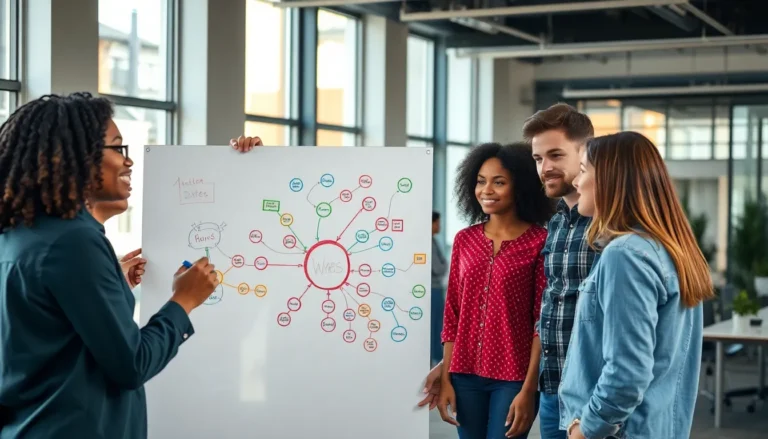Table of Contents
ToggleIn a world overflowing with information, abstract synthesis prompts emerge as the secret sauce for creativity and clarity. These prompts transform chaotic thoughts into structured ideas, making the complex feel simple and the mundane feel extraordinary. Whether you’re a student wrestling with a paper or a professional seeking fresh angles, these prompts can be your trusty sidekick.
Overview of Abstract Synthesis Prompts
Abstract synthesis prompts serve as valuable tools for enhancing creativity. They aid individuals in transitioning from chaotic thoughts to structured ideas. Professionals benefit greatly, as these prompts help clarify complex concepts. Students find that engaging with abstract synthesis prompts fosters deeper understanding.
Utilizing these prompts encourages organized thinking and creativity. They challenge individuals to look beyond surface-level information and explore deeper meanings. This exploration facilitates engagement with ordinary tasks, making them more stimulating and impactful. Specific examples of abstract synthesis prompts include “Describe your ideal world” or “Imagine an object that doesn’t exist.” Such examples stimulate brainstorming and reflection.
The effectiveness of these prompts lies in their ability to guide individuals toward innovation. Individuals often find that abstract synthesis helps in producing unique perspectives. Consequently, this process leads to more compelling ideas. Research indicates that people who use prompts regularly tend to develop stronger analytical skills.
Abstract synthesis prompts attract attention for their role in creativity and organization. Engaging in this practice creates an environment conducive to innovative thinking and clearer communication. Individuals across various fields benefit from integrating these prompts into their routine.
Importance of Abstract Synthesis Prompts

Abstract synthesis prompts play a crucial role in enhancing creativity and fostering deeper understanding. They guide individuals in navigating the complexities of information.
Enhancing Creativity
Creativity thrives through engagement with abstract synthesis prompts. Examples prompt individuals to think outside the box, sparking innovative ideas. They encourage unique perspectives, leading to original solutions. Describing an ideal world, for instance, invites imaginative exploration and expands possibilities. Exploring nonexistent objects challenges conventional thinking, pushing creative boundaries. Regular interaction with these prompts cultivates an environment rich in creativity, making it easier for individuals to express thoughts and ideas. Ultimately, they transform chaos into coherent visions, stimulating creative output across various contexts.
Facilitating Critical Thinking
Critical thinking benefits significantly from abstract synthesis prompts. These prompts require individuals to analyze concepts and challenge assumptions. Engaging with them encourages deeper exploration of topics and encourages weighing various viewpoints. For example, contemplating the impact of technological advancements on society fosters critical analysis. Evaluating potential outcomes leads to thoughtful discussions and well-rounded opinions. Consistent use sharpens analytical skills and enhances structured reasoning. They promote clarity in communication, making individuals more effective thinkers and communicators in their respective domains.
Types of Abstract Synthesis Prompts
Individuals can use various types of abstract synthesis prompts to enhance their creativity and critical thinking. These prompts fall into two main categories: visual prompts and text-based prompts.
Visual Prompts
Visual prompts engage individuals’ imaginations through imagery. Artists, designers, and creative thinkers frequently rely on these stimuli to inspire new ideas. Pictures or abstract paintings can provoke thought and elicit emotional responses. Individuals might analyze colors, shapes, and forms to develop unique interpretations. Utilizing imagery encourages individuals to dive deeper into concepts, sparking innovative ideas with each glance.
Text-Based Prompts
Text-based prompts stimulate creativity through written words. Questions or statements challenge individuals to think beyond conventional boundaries. Examples include “Write a story about a day without technology” or “Describe a conversation between two imaginary characters.” These prompts encourage analytical thinking and creative expression. Writers or thinkers explore various perspectives and build narratives, uncovering potential solutions to complex problems. Engaging with these prompts helps refine communication skills while fostering imaginative exploration.
Best Practices for Using Abstract Synthesis Prompts
Abstract synthesis prompts enhance creativity and thought organization. Following specific best practices maximizes their effectiveness.
Tailoring Prompts to Audience
Understanding the audience’s background and interests is crucial. Customize prompts to align with their experiences and knowledge, ensuring engagement. For example, students might respond better to prompts relating to school projects, while professionals benefit from work-related scenarios. By considering the audience’s preferences, prompts become more relatable. Tailored prompts facilitate deeper connections and understanding, leading to richer creative outputs.
Encouraging Open-Ended Responses
Open-ended responses foster exploration and innovation. Formulate prompts that invite expansive thinking rather than yes-or-no answers. Phrasing like “What would happen if…?” stimulates imagination and encourages elaboration. Such questions compel individuals to analyze concepts and express unique perspectives. Engaging with open-ended prompts nurtures creativity and critical thinking, providing space for diverse ideas. Clear guidance in phrasing opens the conversation, allowing for collaborative and expansive discussions among participants.
Abstract synthesis prompts are invaluable tools that drive creativity and clarity in thought. By transforming chaotic ideas into structured concepts, they empower individuals to engage deeply with complex topics. These prompts not only foster imaginative exploration but also enhance critical thinking skills.
Regular use of both visual and text-based prompts can lead to innovative solutions and unique perspectives. Tailoring prompts to specific audiences ensures maximum engagement and relatability. By encouraging open-ended responses, individuals can unlock their potential for creativity and analytical thinking. Embracing abstract synthesis prompts can truly revolutionize the way people approach problem-solving and communication in their personal and professional lives.







